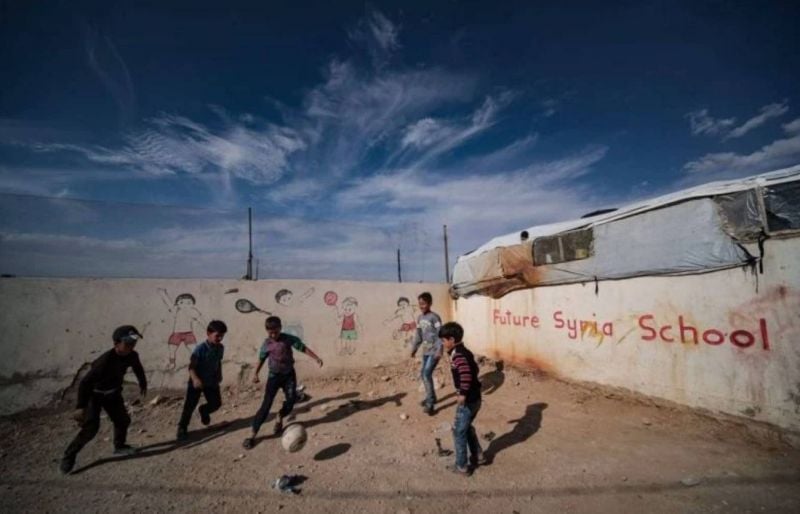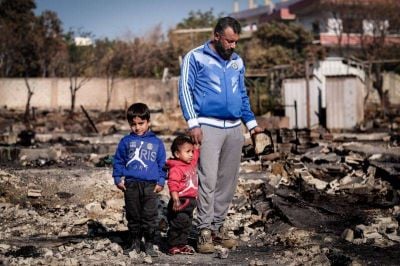
Syrian refugees playing at a camp in Ersal, Oct. 28, 2020. (Credit: João Sousa/L'Orient Today)
Since the start of the Syrian crisis in 2011, the issue of demographic consequences related to the massive influx of refugees into Lebanon has caused a stir.
Fear surrounding change in the country’s political and religious balance has oftentimes been raised, sometimes for populist purposes. It has often been used without basis on accurate and complete data, considering there has been no official census since 1932.
But the debate is likely to take on a new dimension with the data and conclusions of a study published by the Lebanese Citizen Foundation, entitled “Lebanon: migrations and crises; territory, population, State?”
The report’s author, economist and former Minster of Labor Charbel Nahas sought to assess the repercussions of migration on Lebanon. He assessed both the flows of residents who leave Lebanon and those who come to settle in the country.
He notes that the assessment of migratory movements should be based on the recording of arrivals and departures of individuals in and out of the country, and on “an analysis of the institutional [nationality], demographic, sociological and economic characteristics of migrants.” He states that this “exercise is impossible in Lebanon,” and instead opts for an exploitation and extrapolation of the meager existing statistics in this area ( from surveys of the Central Administration of Statistics (CAS); university studies; estimates by international organizations).
Nahas then attempts to support the numbers by identifying migratory flows based on a comparison of emigrant and resident population stocks.
“In the absence of sufficient data, it is inevitable in Lebanon to rely on estimates,” Youssef Courbage, an expert on demography, told L’Orient-Le Jour.
Courbage also believes that “given the information available, or rather the lack of it, the work carried out in this report is remarkable.”
The scale of these flows is a well-established permanent feature of the country’s history, indicates the report. It reviews the various migration waves recorded to and from Lebanon since the 1880s.
The scale and characteristics of the current migratory movements threaten to seriously impact Lebanon’s demography.
“Given the current situation and the systematic inaction of complicit leaders, a drastic change in the demographic fabric of Lebanon, along with all the economic and social repercussions it could have, is already underway,” Nahas, who is the founder of the political party Citizens in a State, told L’Orient-Le Jour.
Harmful emigration
One of the reasons Nahas is sounding the alarm about the nature and scale of Lebanon’s migration patterns, is the difference in fertility rates between the two populations. Among “children between the ages of one and four years, the number of Syrian children is more than double that of Lebanese.”
Similarly, when it comes to youth aged between five and 14, the number of Syrians exceeds that of Lebanese, although this is not the case for youth between 15 and 19.
However, this result “cannot be attributed exclusively to the arrival of Syrian refugees fleeing the war. It is the combination of immigration and emigration flows that has led to this situation,” noted Nahas.
“The Lebanese population has seen a relatively early decline in fertility. While this trend, which began in the 1970s, first affected Christian women, it has since spread to Sunni and then Shiite women too. This is a direct consequence of the improvement in living standards and education, which affects all communities,” said Courbage.
With regard to Lebanese emigrants, Nahas highlighted distinctions between recent emigration, from the 1975 war to the present day, and older emigration, which took place at the end of the 19th and beginning of the 20th centuries.
Whereas the two major waves of emigration from the 1880s and after WWI mainly involved a low-skilled rural population, the recent emigration characterizes a brain drain, mainly constituting the skilled and educated.
It is true that the Lebanese economy has historically, and particularly since the end of the Civil War, relied on emigration to benefit the country’s economy in the form of remittances from expatriates, and even a transfer of know-how when returning to the country.
But to Nahas, this observation needs to be nuanced today.
Emigration “reduces the country’s productive capacity, slows down its economic and social dynamism, and lowers the incomes of the less qualified workers who remain in the country, (...) even though the training of young emigration candidates absorbs a significant proportion of the country’s meager resources” and of the remittances sent by these same expatriates.
According to the report, which cites several international studies on the subject, the brain drain has “negative effects on growth in countries where the emigration rate of people with higher education exceeds 20 percent and/or the percentage of the population receiving higher education exceeds five percent.”
In the case of Lebanon, before the Syrian crisis, these proportions were close to 50 percent and 28 percent respectively, and mainly concerned professionals and graduates, who are more likely to find opportunities in host countries.
This trend has worsened with the onset of the economic and financial crisis. While the country lost an average of almost 25,000 people each year between 1997 and 2018 — for a total of around 550,000 throughout the period — this rate rose to almost 78,000 per year between 2018 and 2023.
Faced with the economic crisis, Lebanon “has found its adjustment variable in massive emigration,” noted Nahas.
“By allowing a large part of its population to emigrate, the state has been able to maintain the semblance of balance of the ‘Lebanese model,’ while running the risk of precipitating the country towards greater instability,” he added.
He went on to warn of a possible demographic catastrophe looming on the horizon, given that “based on the behavior observed between 1997 and 2009, almost half of Lebanese residents aged 15 will emigrate before the end of their work life, with the proportion of boys being higher than girls.”
Fly in the ointment
The report estimated that the Lebanese now represent only between 65 percent and 69 percent of Lebanon’s resident population, compared with 67 percent and 71 percent in 2018 and 80 percent in 2004.
As for the coming years, the study established nine prospective scenarios, based on three variables: Lebanon’s economic restructuring (or lack thereof); possible stability in Syria; and changes in the regional and international environment.
As a result, and depending on these scenarios, the Lebanese could represent between 72 and 52 percent of the country’s total population by 2038 — making up barely half of Lebanon’s resident population in the worst case scenario.
“These estimates are very alarmist. It is unlikely that the most pessimistic scenarios will come true,” said Courbage, who did not rule out the possibility that large numbers of refugees would return to Syria voluntarily.
“With the outbreak of war in Gaza, the resumption of tensions in Lebanon, the relative calm in Syria, and even the worsening Lebanese economic crisis, many Syrians and Palestinians from Syria could return,” he argued, but for this to happen, the regime in power “must not hinder this return.”
This interpretation differs from that of most NGOs and international organizations, which continue to point the finger at the risks of returning to Syria.
Beyond these scenarios and their implications, Nahas believes there is still a way to contain the scale of the change underway by limiting “excessive immigration” and avoiding “emigration becoming the only response to the crisis,” he noted.
“As ridiculous as it may sound, the first step is to take note of this trend and carry out a census of the entire resident population, Lebanese and foreigners, and then of Lebanese emigrants,” he told L’Orient-Le Jour.
He pointed out that “the governments repeatedly cut funding [to the CAS] to stop the publication of certain indices.”
The census is far from being the only fly in the ointment according to Nahas, who called for talks with the Syrian regime on migration.
Another major challenge — at a time when the Lebanese education system is paying a heavy price for the crisis — is the proposal to put in place “mechanisms to ensure appropriate education for the entire population, which will have an impact on the fertility rate of part of this population and will make it possible to control its growth” in the longer term.
As far as emigration is concerned, Nahas proposed urgent action to limit the exodus of a large part of the skilled workforce.
“Firstly, the state, as much as there is a state in Lebanon, should put in place economic and social incentives with the aim of keeping skilled individuals in Lebanon. If these measures do not produce the desired results, the state could then consider a sort of exit tax, as in the United States,” he said.
However, these proposals have little chance of becoming reality if we consider, as Nahas does, that “by introducing such measures, the political class would be endangering the existence of a system that it has shaped and whose survival depends on the remittances sent by these emigrants.”
However, he argued, “we cannot allow a society to become self-destructive.”
This article was originally published in French in L'Orient-Le Jour. Translation by Joelle El Khoury.

